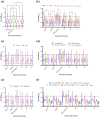Clinical features and severe acute respiratory syndrome-coronavirus-2 structural protein-based serology of Mexican children and adolescents with coronavirus disease 2019
- PMID: 35969583
- PMCID: PMC9377623
- DOI: 10.1371/journal.pone.0273097
Clinical features and severe acute respiratory syndrome-coronavirus-2 structural protein-based serology of Mexican children and adolescents with coronavirus disease 2019
Abstract
Severe acute respiratory syndrome (SARS)-coronavirus (CoV)-2 infection in children and adolescents primarily causes mild or asymptomatic coronavirus disease 2019 (COVID-19), and severe illness is mainly associated with comorbidities. However, the worldwide prevalence of COVID-19 in this population is only 1%-2%. In Mexico, the prevalence of COVID-19 in children has increased to 10%. As serology-based studies are scarce, we analyzed the clinical features and serological response (SARS-CoV-2 structural proteins) of children and adolescents who visited the Hospital Infantil de México Federico Gómez (October 2020-March 2021). The majority were 9-year-old children without comorbidities who were treated as outpatients and had mild-to-moderate illness. Children aged 6-10 years and adolescents aged 11-15 years had the maximum number of symptoms, including those with obesity. Nevertheless, children with comorbidities such as immunosuppression, leukemia, and obesity exhibited the lowest antibody response, whereas those aged 1-5 years with heart disease had the highest levels of antibodies. The SARS-CoV-2 spike receptor-binding domain-localized peptides and M and E proteins had the best antibody response. In conclusion, Mexican children and adolescents with COVID-19 represent a heterogeneous population, and comorbidities play an important role in the antibody response against SARS-CoV-2 infection.
Conflict of interest statement
The authors have declared that no competing interests exist.
Figures


Similar articles
-
Clinical Characteristics of Coronavirus Disease (COVID-19) in Mexican Children and Adolescents.Viruses. 2022 Sep 30;14(10):2162. doi: 10.3390/v14102162. Viruses. 2022. PMID: 36298717 Free PMC article.
-
Quantitative SARS-CoV-2 Serology in Children With Multisystem Inflammatory Syndrome (MIS-C).Pediatrics. 2020 Dec;146(6):e2020018242. doi: 10.1542/peds.2020-018242. Epub 2020 Sep 2. Pediatrics. 2020. PMID: 32879033
-
Heterogeneous antibodies against SARS-CoV-2 spike receptor binding domain and nucleocapsid with implications for COVID-19 immunity.JCI Insight. 2020 Sep 17;5(18):e142386. doi: 10.1172/jci.insight.142386. JCI Insight. 2020. PMID: 32796155 Free PMC article.
-
Human and novel coronavirus infections in children: a review.Paediatr Int Child Health. 2021 Feb;41(1):36-55. doi: 10.1080/20469047.2020.1781356. Epub 2020 Jun 25. Paediatr Int Child Health. 2021. PMID: 32584199 Review.
-
COVID-19 Severe acute respiratory syndrome coronavirus 2 (SARS-CoV-2) infection in children and adolescents: a systematic review of critically unwell children and the association with underlying comorbidities.Eur J Pediatr. 2021 Mar;180(3):689-697. doi: 10.1007/s00431-020-03801-6. Epub 2020 Sep 10. Eur J Pediatr. 2021. PMID: 32914200 Free PMC article.
Cited by
-
Detection of IgG antibodies against the receptor binding domain of the spike protein and nucleocapsid of SARS-CoV-2 at university students from Southern Mexico: a cross-sectional study.BMC Infect Dis. 2024 Jun 12;24(1):584. doi: 10.1186/s12879-024-09435-5. BMC Infect Dis. 2024. PMID: 38867165 Free PMC article.
-
Demographic and clinical factors are relevant in respiratory infections among paediatric patients: a cross-sectional study in Mexico.Eur J Clin Microbiol Infect Dis. 2025 Aug;44(8):1995-2005. doi: 10.1007/s10096-025-05168-8. Epub 2025 May 23. Eur J Clin Microbiol Infect Dis. 2025. PMID: 40408042
-
Frequency of respiratory virus-associated infection among children and adolescents from a tertiary-care hospital in Mexico City.Sci Rep. 2023 Nov 13;13(1):19763. doi: 10.1038/s41598-023-47035-6. Sci Rep. 2023. PMID: 37957308 Free PMC article.
-
Clinical Characteristics of Coronavirus Disease (COVID-19) in Mexican Children and Adolescents.Viruses. 2022 Sep 30;14(10):2162. doi: 10.3390/v14102162. Viruses. 2022. PMID: 36298717 Free PMC article.
-
Seroprevalence of IgG and Subclasses against the Nucleocapsid of SARS-CoV-2 in Health Workers.Viruses. 2023 Apr 13;15(4):955. doi: 10.3390/v15040955. Viruses. 2023. PMID: 37112935 Free PMC article.
References
Publication types
MeSH terms
Substances
LinkOut - more resources
Full Text Sources
Medical
Research Materials
Miscellaneous

